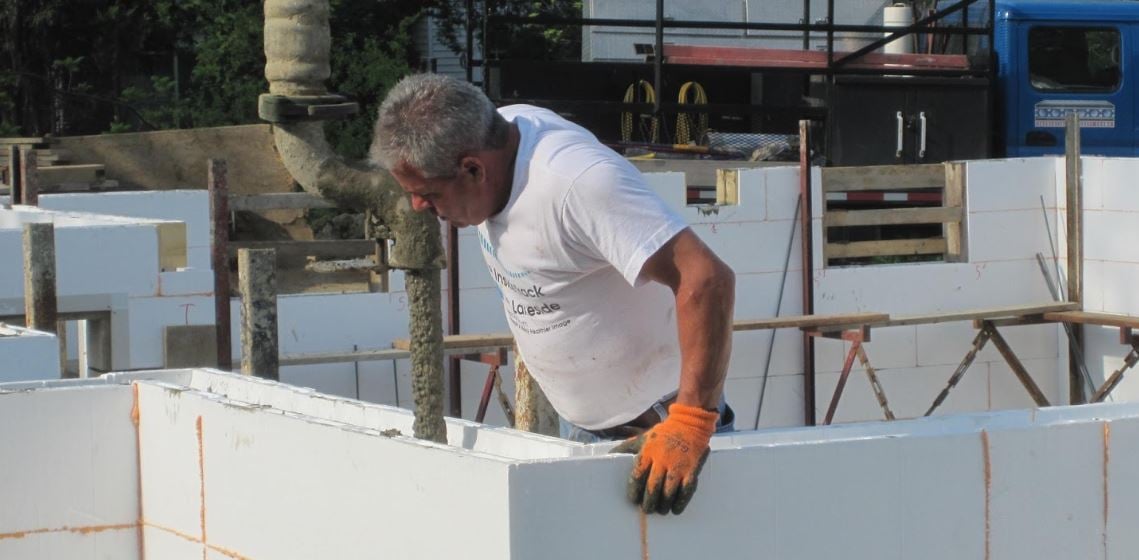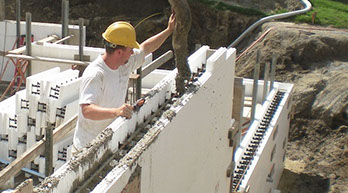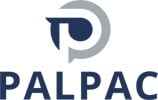ICFs are forms for poured concrete walls that stay in place as a permanent part of the wall assembly, serving as continuous insulation as well as a barrier against air and sound entry. To give the wall greater strength, steel reinforcement is placed both horizontally and vertically in the forms before the concrete is pumped or poured inside.
ICF forms are made of various types of foam insulation and come in two basic configurations: hollow-core blocks that stack and interlock like Legos and individual panels or planks that connect with plastic or steel ties. Within these basic categories are many different ICF products, differentiated based on the structural configuration they form (such as a flat wall, post-and-beam, or grid system), how the forms attach together, how finishes attach to the wall, thickness, and insulating values.
Installation of insulating concrete form systems is similar to masonry construction. Builders usually start at the corners and place a layer at a time to build up the wall. Some units, particularly those that form a “waffle” or post–and–beam concrete wall profile must be glued together or taped at the joints during assembly. Most systems today feature uniform cavities that improve flowability of the concrete, reduce the need for adhesives during stacking, resulting in flat concrete walls of consistent thickness.

Once the forms are in place and braced and required reinforcement installed, concrete is pumped into the forms. Even with the bracing, forms need to be filled at an appropriate rate based on formwork manufacturer recommendation to prevent misalignment and blowouts. Product advancements and improved construction techniques have greatly reduced the potential for form failure. Reinforcement in both directions maintains the wall strength. Openings for doors and windows require bucks to surround the opening, contain the fresh concrete during placement, and provide suitable material for fastening window or door frames.

Block-outs are needed when bearing pockets are required for floor or roof items. Insulating concrete form systems are compatible with concrete floors, and wood or steel floor joists. In smaller buildings, ledger assemblies for floor framing attachment mounted to the side of the formwork are common. In larger buildings or those for commercial uses, steel weld plates or bolt plates can be pre-installed within the formwork, so they become embedded in the fresh concrete.
Finishes are usually attached via the flat ends of metal or plastic ties embedded in the forming material. Finishes can alternately be furred out with furring strips. Almost any type of finish can be used with these systems. Wallboard remains the most common interior finish and is the most typical means of meeting the code requirement for a 15-minute fire barrier over plastic foams surrounding living spaces. Exteriors are much more varied and depend on customer preference. Cement plasters are applied over ICFs in a manner like other sheathed systems.
From a builder's perspective, ICF systems offer numerous advantages over other types of concrete wall construction:
- The foam forms are lightweight and easy to erect; bracing and alignment systems are provided by most manufacturers.
- Because the forms remain in place, contractors can build concrete walls in less time—in as little as a day for a typical house foundation.
- Inserting utilities is as easy as cutting channels or grooves using an electric hot knife or router.
- The insulating forms protect the concrete from temperature extremes, permitting concrete to be placed at below-freezing temperatures and extending the construction season by several months in cold climates.
- The pre-insulated walls eliminate the need for additional insulation and the labor cost of installing it.
- Exterior siding and interior drywall can typically be attached directly to the form faces, with many ICFs incorporating integral attachment systems.
Other benefits include:
- Strength: Structural Safety and Hazard Mitigation Benefits (Tornado, Hurricane Earthquake, Fire, etc.)
- Durability: ICFs protect against moisture and termites
- Energy Efficiency: ICF wall construction can provide 20 to 40% savings in annual heating and cooling costs to conventional wood-frame walls
- Comfort, Noise Control: ICFs provide a higher STC rating than wood-frame walls
Please call or email us to learn more.


